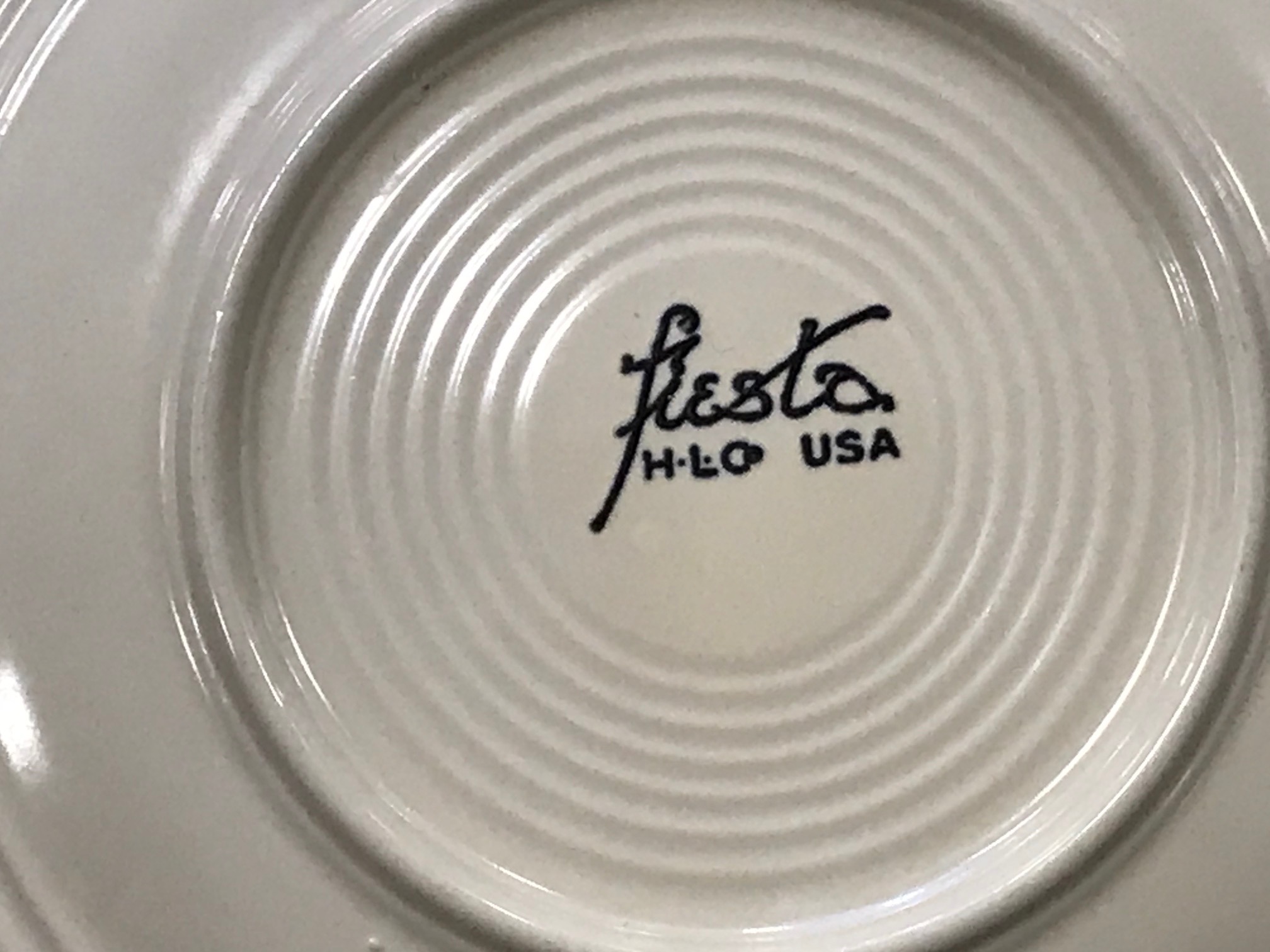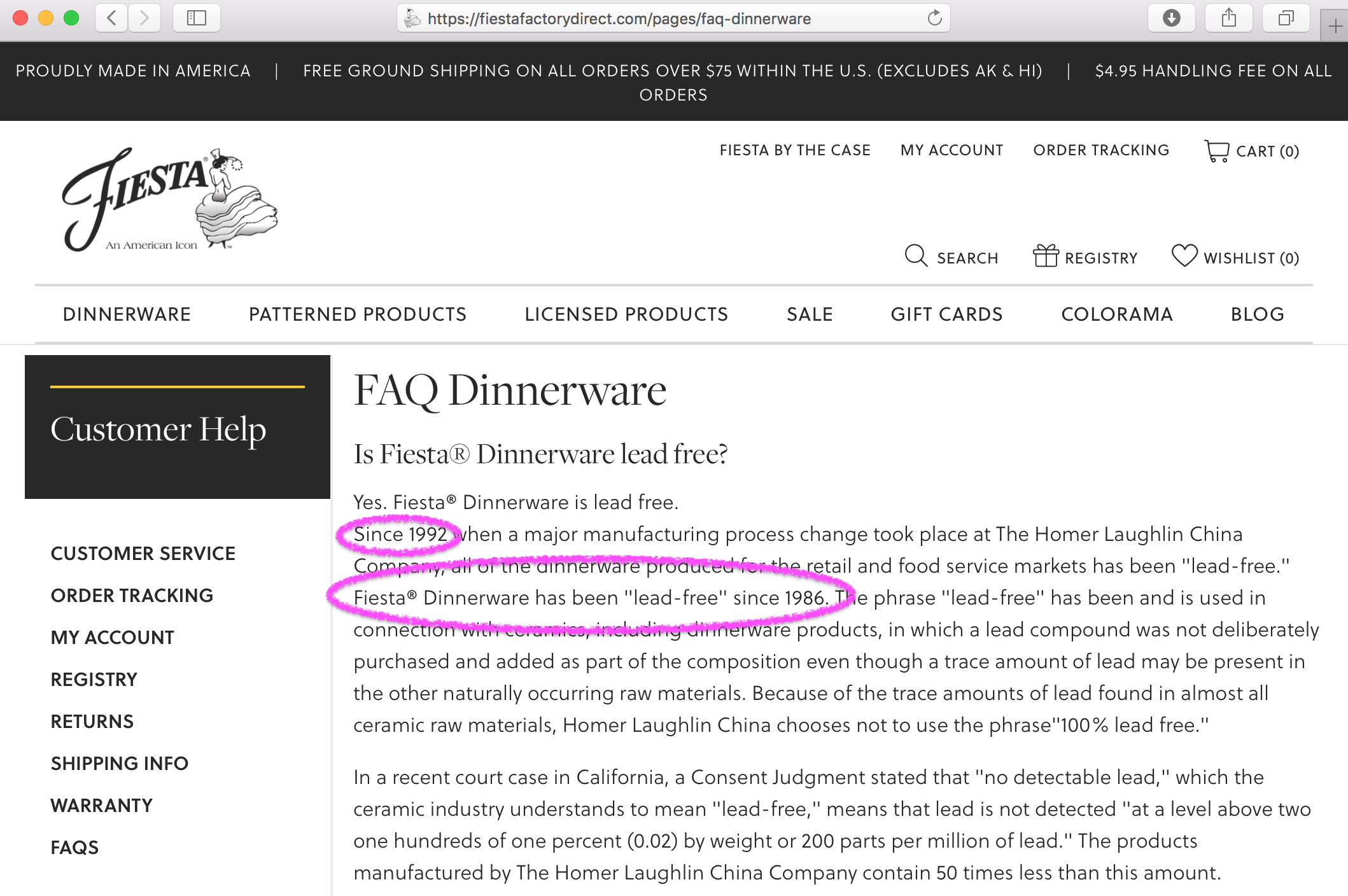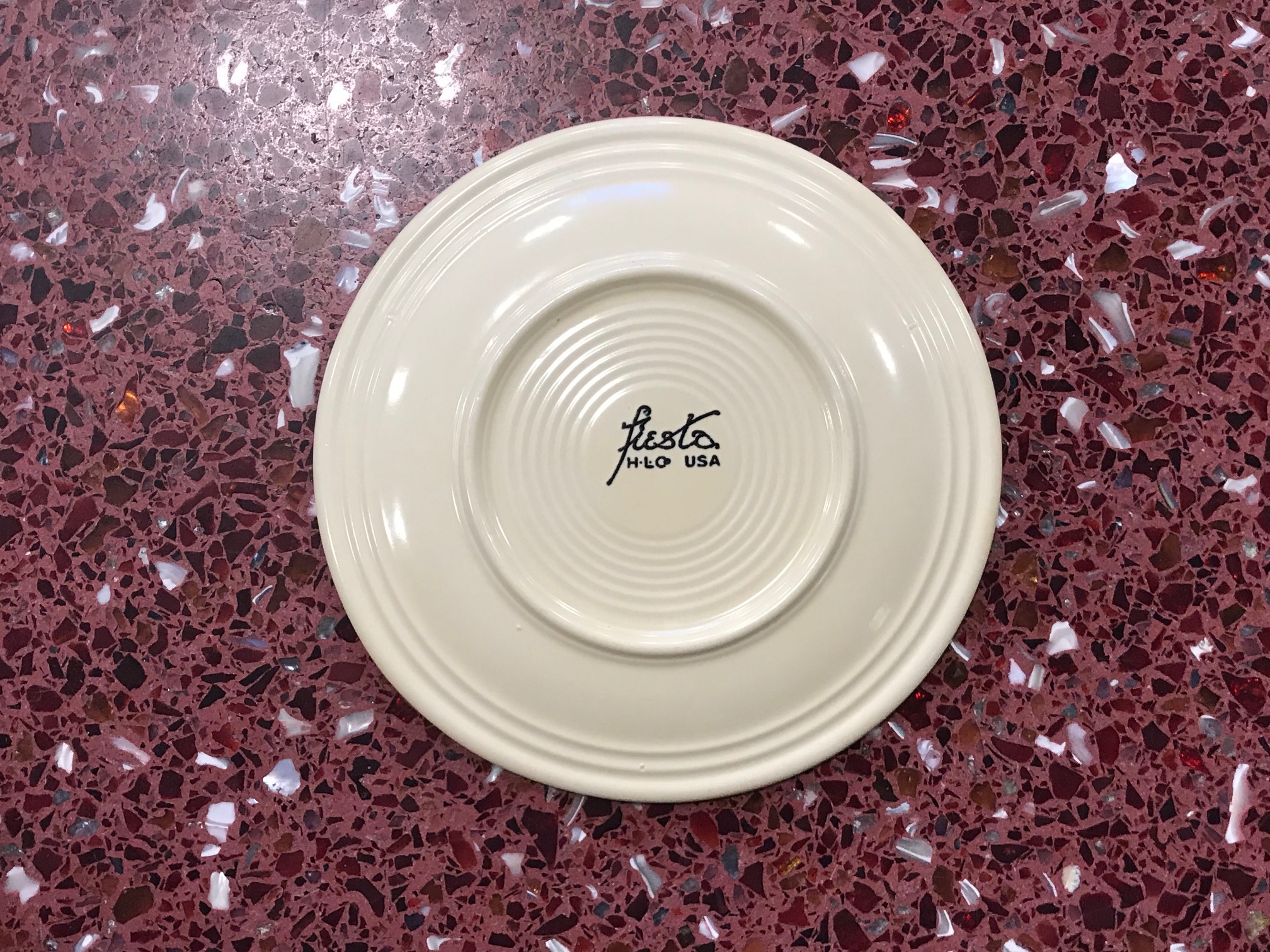Vintage cream ceramic Fiesta dish: 74,700 ppm Lead. That’s about 7.5% Lead! 90 ppm is unsafe for kids.

 When tested with an XRF instrument the white / cream glaze of this vintage Fiesta brand ceramic plate pictured here had the following readings:
When tested with an XRF instrument the white / cream glaze of this vintage Fiesta brand ceramic plate pictured here had the following readings:
- Lead (Pb): 74,700 +/- 2,600 ppm
- Tin (Sn): 3,197 +/- 195 ppm
- Zinc (Zn): 16,400 +/- 600 ppm
- Iron (Fe); 638 +/- 199 ppm
- Titanium (Ti): 4,431 +/- 316 ppm
What is “vintage”?
For those new to the world of vintage and antique items, in collectors’ circles, “vintage” is commonly understood to refer to an item that is more than 20-25 years old. So – odd as it may seem, as of today [January 31, 2020], anything from 2000 or thereabouts [and, of course, anything from the several decades preceding] would generally be considered “vintage”. The term “antique” is formally reserved for items at least 100 years old.
Since Fiesta states on their website that they stopped using Lead (as an intentional ingredient) in their products as of 1992, and since 1992 was 28 years ago as of the moment of publishing this post – for the purpose of Fiestaware (specifically in relation to the conversation about Lead), we’re going to use the term “vintage” to mean “1992 or earlier.”
I have no way to know the exact age or year of manufacture for this particular piece — as it is not marked in any way that would indicate the year of manufacture (to someone who isn’t an avid collector of these products); if you have some insight as to the potential year of manufacture for this piece (besides “before 1992”), please do let me know.*
Some background on Fiesta and heavy metal toxicants…
I do have some Fiesta company documents that discuss their historic use of toxic heavy metals (shared with me by a reader who had an e-mail exchange with Fiesta), and I will be publishing those soon [and will link it here when it is up – so stand by for that].
In the meantime, their website actually claims two different dates for their cessation of using lead — both “1986″ and “1992″. [Here’s the page that currently lists both 1992 and 1986 as the year they went “Lead Free” officially. (see image below too!)]
Continue reading below the image:
Again – 1992 was, at this moment, 28 years ago – so that does put the Lead-glazed pieces officially in the era of “vintage”. However, to be clear, I have found trace Lead even in brand-new/modern pieces that I have tested from this company [I have also found modern pieces from Fiesta with traces of Arsenic and Cadmium.] To see some examples of “modern” Fiestaware that I have tested, click here.
What about the pieces marked “Lead-Free” on the bottom?
Are they truly Lead-free?
I have actually tested some of their newer pieces marked “Lead Free” and found Lead in them (albeit at “trace” levels – usually below 100 ppm). However, since I first made this information public – probably 6 or 7 years ago, since the company became aware of my findings of Lead [via high-precision XRF testing] in their “Lead-free” pieces – I believe they stopped stamping the bottoms of their pieces with the words “Lead Free”, as the currently-manufactured items that I have seen (2019-2020) don’t seem to have that imprint on the bottom. They also have a public statement that essentially attempts to denounce the validity of XRF technology (!), and in their literature they claim a novel definition of “Lead-free” [they just made up how they can define words, lol!]
Wait.
What?
They claim a unique definition for the words “Lead-Free?”
Yep! [That’s where they really start to bug me!] Specifically, their website contains the astonishing doublespeak:
“The phrase “lead-free” has been and is used in connection with ceramics, including dinnerware products, in which a lead compound was not deliberately purchased and added as part of the composition even though a trace amount of lead may be present in the other naturally occurring raw materials. Because of the trace amounts of lead found in almost all ceramic raw materials, Homer Laughlin China chooses not to use the phrase “100% lead free.”
In a recent court case in California, a Consent Judgment stated that “no detectable lead,” which the ceramic industry understands to mean “lead-free,” means that lead is not detected “at a level above two one hundreds of one percent (0.02) by weight or 200 parts per million of lead.” The products manufactured by The Homer Laughlin China Company contain 50 times less than this amount.”
Nope. You guys made up this definition of “Lead Free”! As it happens, my mother was a potter…
Ceramics are only “Lead-free” if they are actually Lead-free! If they test positive for Lead using ANY methodology they are – in fact – NOT Lead-free. This language above is clearly Homer Laughlin trying to use some after-the-fact doublespeak to justify the fact that many of their dishes that were marked “Lead Free” on the bottom were not actually Lead-free. [Also that “50 times less” statement is clearly B.S. as I have detected levels far above “50 times less” than 200 ppm in new Fiesta pieces. What does “50 times less” mean anyway? What is “50 times less” than 200 ppm? I’m not quite sure what they mean by that! Lol.]
What years of Fiesta are the highest Lead?
As with many other brands of dishware, it is also safe to assume that for each decade we go back (before the year they declared themselves to be “Lead-free” in 1992) it is likely that the Lead level potentially increases significantly with the period (as well as there being variations with the colors.) I have thus seen Lead levels with these vintage pieces from this brand in the range of 60,000 ppm to 600,000 ppm Lead and – if this company is like other companies – the 600,000 ppm Lead is likely from the first part of the 20th century and the Lead levels likely get lower as we approach 1992.
As a result – for the white / cream glazed plate in question in this post – I will take an educated guess that it is likely from c. 1950 to 1960 (a conclusion drawn based on the color, the presence of a back mark* and XRF detectable Lead level), but – while, at this point I may be a bit of an expert in dating consumer goods by their color and style – I am by no means an expert on Fiesta ware specifically – so would be appreciative of any additional input.
*Note: I have not yet researched the back marks of these in great depth. I know what the newer ones look like (past 10 years about) and I know that the older pieces often have no back mark at all, which would further push this piece into that range (somewhere in the middle of the past 100 years!), but it could be from possibly an earlier or later decade (1970s / 1980s).
How much Lead is “too much” Lead?
The amount of Lead that is considered unsafe and illegal in a modern / newly-manufactured item made and sold as “intended for use by children” today is anything 90 ppm Lead or higher in the paint / glaze or coating, and anything 100 ppm Lead or higher in the substrate. Dishes and tableware are not covered by this regulatory standard, although it is my opinion that they should be — because children also use dishes! Needless to say, this is a very high amount of Lead, especially for something intended for food-use purposes. To reiterate what I said above: I would not consider these vintage Fiesta dishes safe for food use purposes under any interpretation or by any standard.
Some additional reading:
- To read more about the concern for Lead in pottery and dishware, click here.
- To see more Fiesta items that I have tested, click here.
- To read more about the type of testing I do, click here.
As always, please let me know if you have any questions.
Thank you for reading and for sharing my posts.
Tamara Rubin
#LeadSafeMama
Never Miss an Important Article Again!
Join our Email List


 When tested with an XRF instrument the white / cream glaze of this vintage Fiesta brand ceramic plate pictured here had the following readings:
When tested with an XRF instrument the white / cream glaze of this vintage Fiesta brand ceramic plate pictured here had the following readings:


Hello Tamara,
Thanks for all you do!!! Just looking for clarification, when you say the glaze tested at a high ppm level for lead, is it the glaze itself, or perhaps is it the materials stoneware within the glaze? I’d imagine the xrf gun goes through all of this so high levels could be in the food contact area/glaze, but is it possible it’s in the ‘center’ of the dish, where no food is contacted (unless chopped of course)? I’m really curious as to what the gun is testing, thanks so much 🙂
Hi Cora – it is the surface glaze that is positive for high levels of Lead, the part that touches the food.
Tamara
The plate is an original production
The color is called Ivory and was produced from 1936 to 1951.
Thank you!
HLC produced many lines of dishes–not just Fiesta. The Fiesta line has been lead free since 1986. All HLC lines have been lead free since 1992 (or before). There are not 2 dates for Fiesta.
HLC did not produce Fiesta between 1972 and 1986. So any Fiesta with lead was made prior to 1972. Items with the most lead was produced from the 30s to the 50s, such as the examples you give in the article.
Fiesta collectors only refer to “vintage” Fiesta as the items produced between 1936-1972. Fiesta made from 1986 to present is referred to as “p86.” Even though 1986 produced items are 35 years old (they are date stamped) it is NOT referred to as vintage by Fiesta collectors. It is called p86 or post-86.